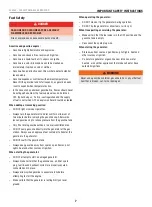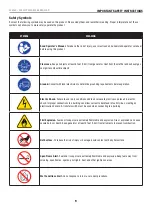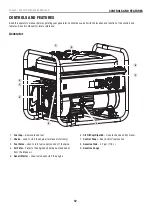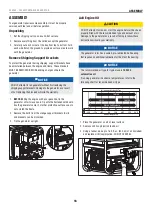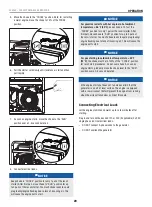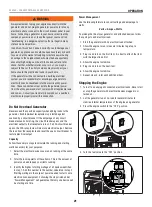
200963 - 3500W PORTABLE GENERATOR
OPERATION
21
WARNING
Always remember to plug your appliances directly into the
generator and do not plug the generator power cord into any
electrical outlet or connect to the circuit breaker panel in your
home. Connecting a generator to your home’s electric utility
company’s power lines, or to another power source, called
‘backfeeding’ is a dangerous practice that is illegal in many
states and municipalities.
In addition, this action if done incorrectly, could damage your
generator, appliances and could cause serious injury or death
to you or a utility worker attempting to restore power during
an outage to the neighborhood who may then unexpectedly
encounter high voltage on the utility line and suffer a fatal
shock. Further, whether injuries occur or not, you may be
subject to fines or the utility company may disconnect your
home should this practice be found in your home.
If the generator will be connected to a building electrical
system, you are responsible for ensuring your generator’s
electricity does not backfeed into the electric utility power
lines. These connections must isolate the generator power
from the utility power and must comply with all applicable laws
and codes – Consult your local utility company or a qualified
electrician to properly install this connection.
Do Not Overload Generator
Never exceed the specified capacity when adding loads to the
generator. Each individual receptacles is protected against
overload by a circuit breaker. If the amperage of any circuit
breaker exceeds its rating, the circuit breaker opens and the
electrical output to that receptacle is lost. If a 30A circuit breaker
opens, the 20A receptacle will also lose electrical output. Remove
the load from the receptacle and reset the open circuit breaker to
restore electrical output.
Capacity
Follow these simple steps to calculate the running and starting
watts necessary for your purposes:
1. Select the electrical devices you plan on running at the same
time.
2. Total the running watts of these items. This is the amount of
power you need to keep your items running.
3. Identify the highest starting wattage of all devices identified
in step 1. Add this number to the number calculated in step 2.
Starting wattage is the surge of power needed to start some
electric driven equipment. Following the steps listed under
“Power Management” will guarantee that only one device will
be starting at a time.
Power Management
Use the following formula to convert voltage and amperage to
watts:
Volts × Amps = Watts
To prolong the life of your generator and attached devices, follow
these steps to add electrical load:
1. Start the generator with no electrical load attached.
2. Allow the engine to run for several minutes to get up to
temperature.
3. Plug in and turn on the first item. It is best to attach the item
with the largest load first.
4. Allow the engine to stabilize.
5. Plug in and turn on the next item.
6. Allow the engine to stabilize.
7. Repeat steps 5-6 for each additional item.
Stopping the Engine
1. Turn off and unplug all connected electrical loads. Never start
or stop the generator with electrical devices plugged in or
turned on.
2. Let the generator run at no-load for several minutes to
stabilize internal temperatures of the engine and generator.
3. Press the engine switch to the “OFF” position.
4. Turn the fuel valve to the “OFF” position.

